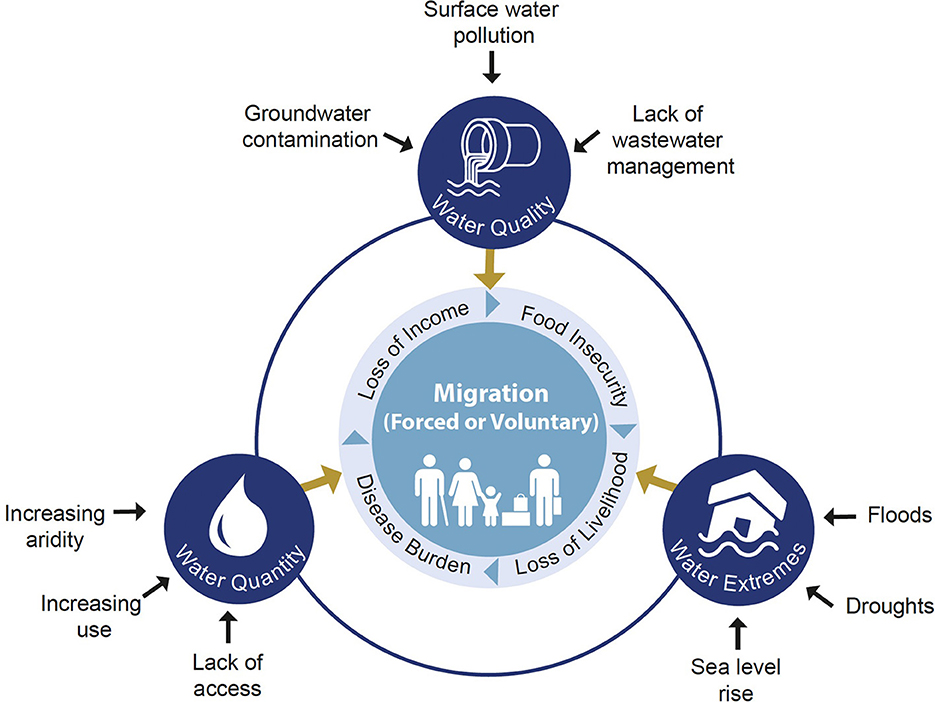
95% of researchers rate our articles as excellent or good
Learn more about the work of our research integrity team to safeguard the quality of each article we publish.
Find out more
CORRECTION article
Front. Hum. Dyn. , 14 March 2023
Sec. Migration and Society
Volume 5 - 2023 | https://doi.org/10.3389/fhumd.2023.1160191
This article is part of the Research Topic Water-Gender-Migration: The Complex Nexus and Interlinkages View all 6 articles
This article is a correction to:
Assessment of Water-Migration-Gender Interconnections in Ethiopia
A corrigendum on
Assessment of water-migration-gender interconnections in Ethiopia
by Färber, L., Nagabhatla, N., and Ruyssen, I. (2022). Front. Hum. Dyn. 4:858229. doi: 10.3389/fhumd.2022.858229
In the published article, there was an error in the caption of Figure 1 as published. The citation “Nagabhatla et al., 2020b” was incorrect. The correct caption appears below:

Figure 1. Three-dimensional framework to assess the water-migration interconnections (Source: Nagabhatla et al., 2020a).
In the published article there was an error in the Introduction, paragraph 1. The citation “Nagabhatla et al., 2020b” is incorrect. The sentence previously stated:
“The temporal and spatial heterogeneity in a country's ability to manage women's particular demands in migration and livelihoods are relatively under-researched despite the fact that in Africa and Asia, 70 % of women and girls are responsible for domestic water collection and often migrate less than men (Nagabhatla et al., 2020b).”
The correct sentence appears below:
“The temporal and spatial heterogeneity in a country's ability to manage women's particular demands in migration and livelihoods are relatively under-researched despite the fact that in Africa and Asia, 70% of women and girls are responsible for domestic water collection and often migrate less than men (Nagabhatla et al., 2020a)”.
In the published article there was an error in the Introduction, paragraph 3. The sentence previously stated:
“To assess the nexus, a three-dimensional framework outlined by Nagabhatla et al. (2020b) was used as a base guiding framework…”
The correct sentence appears below:
“To assess the nexus, a three-dimensional framework outlined by Nagabhatla et al. (2020a) was used as a base guiding framework…”
In the published article there was an error in the Related Literature, paragraph 1. The citation “Nagabhatla et al., 2020b” is incorrect. The sentence previously stated:
“A considerable amount of information and literature sources, national and international agencies and agendas, and development reports make a general reference to “environmental migration” and “climate migrants” (Beine and Jeusette, 2019; Nagabhatla et al., 2020b; UNESCO UN-Water, 2020)…”
The correct sentence appears below:
“A considerable amount of information and literature sources, national and international agencies and agendas, and development reports make a general reference to “environmental migration” and “climate migrants” (Beine and Jeusette, 2019; Nagabhatla et al., 2020; UNESCO UN-Water, 2020)…”
In the published article there was an error in the Methodology, “Guiding Framework and Research Design,” paragraph 1. The citation “Nagabhatla et al., 2020b” is incorrect. The sentence previously stated:
“The conceptional framework (Figure 1) outlined by Nagabhatla et al. (2020b)…”
The correct sentence appears below:
“The conceptional framework (Figure 1) outlined by Nagabhatla et al. (2020a)…”
In the published article, the reference for PHEEC, 2020 was written as “Ethiopia (2020). 2030 The Pathway to Prosperity. Ten Years Perspective Development Plan (2021–2030).” It should be “PHEEC. (2020). Ethiopia 2030: The Pathway to Prosperity. Ten Years Perspective Development Plan (2021-2030).”
The authors apologize for these errors and state that they do not change the scientific conclusions of the article in any way. The original article has been updated.
All claims expressed in this article are solely those of the authors and do not necessarily represent those of their affiliated organizations, or those of the publisher, the editors and the reviewers. Any product that may be evaluated in this article, or claim that may be made by its manufacturer, is not guaranteed or endorsed by the publisher.
Beine, M., and Jeusette, L. (2019). A meta-analysis of the literature on climate change and migration. IZA Discuss. Paper. 19, 12639. doi: 10.2139/ssrn.3468587
Nagabhatla, N., Pouramin, P., Brahmnbhatt, R., Fioret, C., Glickman, T., Newbold, K. B., et al. (2020a). Water and Migration: A Global Overview.
Nagabhatla, N., Pouramin, P., Shin, S., Sharma, P., Glickman, T., Brahmbhatt, R., et al. (2020b). Water and food security crisis influencing human mobility patterns: a comprehensive overview. Food Security Land Use Change Under Conditions Clim. Variabil. Multidimension. Perspect. 20, 49–76. doi: 10.1007/978-3-030-36762-6_4
Nagabhatla, N., Ruyssen, I., Ait L'Houssain, A., Sayan, R. C., and Debevec, L. (2020). Water-Gender-Migration: The Complex Nexus and Interlinkages. Available online at: https://www.frontiersin.org/research-topics/18028/water-gender-migration-the-complex-nexus-and-interlinkages?fbclid=IwAR27_ubt3-6k-BIA9eNR5EX3o8dMlxnwpJrxK65xbxVA_JN74Wsy_jcLXAk (accessed July 15, 2021).
PHEEC. (2020). Ethiopia 2030: The Pathway to Prosperity. Ten Years Perspective Development Plan (2021-2030).
Keywords: water stress, migration, gender, Ethiopia, internal displacement
Citation: Färber L, Nagabhatla N and Ruyssen I (2023) Corrigendum: Assessment of water-migration-gender interconnections in Ethiopia. Front. Hum. Dyn. 5:1160191. doi: 10.3389/fhumd.2023.1160191
Received: 06 February 2023; Accepted: 27 February 2023;
Published: 14 March 2023.
Approved by:
Frontiers Editorial Office, Frontiers Media SA, SwitzerlandCopyright © 2023 Färber, Nagabhatla and Ruyssen. This is an open-access article distributed under the terms of the Creative Commons Attribution License (CC BY). The use, distribution or reproduction in other forums is permitted, provided the original author(s) and the copyright owner(s) are credited and that the original publication in this journal is cited, in accordance with accepted academic practice. No use, distribution or reproduction is permitted which does not comply with these terms.
*Correspondence: Lisa Färber, bGlzYS5qLmZhZXJiZXJAZ21haWwuY29t
Disclaimer: All claims expressed in this article are solely those of the authors and do not necessarily represent those of their affiliated organizations, or those of the publisher, the editors and the reviewers. Any product that may be evaluated in this article or claim that may be made by its manufacturer is not guaranteed or endorsed by the publisher.
Research integrity at Frontiers

Learn more about the work of our research integrity team to safeguard the quality of each article we publish.